Jonathan Tobin, OMS-III¹; Tamir Abbasi, OMS-III¹; Justin Nguyen, OMS-III²; Phillip Dunn, OMS-III¹; Isabella Cashin, OMS-IV¹; Matthew Chung, DO¹
¹ Edward Via College of Osteopathic Medicine, Virginia Campus
² Edward Via College of Osteopathic Medicine, Louisiana Campus
DOI: 10.70709/ec1mfy8wep
Abstract
Background
Pickleball is experiencing a surge in popularity, particularly among older adults, due to its accessibility and low physical demands. However, the increasing participation has been accompanied by a rise in pickleball-related injuries, especially among older individuals. Existing studies focus predominantly on older populations, with limited attention to the recent demographic shifts and growth in participation. This study aims to investigate the incidence, causes, and demographic characteristics of pickleball-related injuries over the past decade, with the hypothesis that injury rates have risen in correlation with the sport’s increasing popularity, particularly among older adults.
Methods
Using the U.S. Consumer Product Safety Commission’s National Electronic Injury Surveillance System (NEISS) database, we retrospectively analyzed pickleball-related injuries reported between 2013 and 2022. National estimates were calculated based on weighted sample data. Google Trends data were used to evaluate the correlation between pickleball’s growing popularity and injury rates. Statistical analyses included descriptive statistics and chi-squared tests.
Results
A total of 1,238 injuries were identified, yielding a national estimate of 77,963 injuries. The most common injuries were fractures (27%) and sprains (27%). Injuries were predominantly concentrated in the upper trunk, lower trunk, and wrist. The majority (91%) of injuries occurred in players aged 50 and older, with an 88% increase in injury rates since 2020. A correlation between Google search volume for pickleball and injury incidence was also observed.
Conclusion
The growing popularity of pickleball has been accompanied by a rise in injuries, particularly among older adults. Healthcare providers should focus on injury prevention strategies, including player education and risk mitigation, to ensure the sport remains safe and accessible for all participants.
Keywords: Pickleball, Sports, Fracture, Trend
Introduction
Pickleball, recognized for its accessibility and engaging gameplay, is a sport traditionally associated with an older patient population (1). The sport’s relatively low physical demands align well with the preferences of many older players. Within recent years, there has been a notable surge in the sport’s popularity. The 2023 Sports & Fitness Industry Association’s (SFIA) Topline Participation Report identified pickleball as America’s fastest-growing sport for the third consecutive year (2,3). In addition to the growing popularity, there has been a discernible increase in participation among younger individuals. In 2021, the average age of all pickleball players decreased to 38.1 years, marking a decline of 2.9 years from the previous year (2). Notably, the most rapid growth in total participation from 2020 to 2021 occurred among individuals under 24 years old, with an increase of 21% (2). With an increase in popularity over recent years, there has been a growing need to characterize the injury landscape associated with the sport. Existing studies on pickleball-related injuries have primarily focused on the older player demographic or have not included an assessment of the recent growth in popularity (4–6). The recent surge in participation and specific injury mechanisms associated with players have not been fully addressed in the literature. This study examines the incidence, causes, and demographic characteristics of pickleball-related injuries between 2013 and 2022. The central purpose of this study is to investigate the incidence, causes, and demographic characteristics of pickleball-related injuries over the past decade, with the hypothesis that injury rates have risen in correlation with the sport’s increasing popularity, particularly among older adults. We aim to contribute insights into the injury patterns of pickleball and inform strategies for injury prevention and management within this evolving sporting community.
Methods
Using the U.S. Consumer Product Safety Commission’s National Electronic Injury Surveillance System Database (NEISS), this retrospective study identified national estimates for pickleball-related injuries sustained during 2013-2022 (12). Queried cases mentioning “pickle” or “pickleball” were filtered and individually evaluated to confirm they met the inclusion criteria. Descriptive statistics were conducted for all variables, and chi-squared testing was used to compare categorical variables. Incidence rates were calculated using NEISS sample weights. Information gathered from the NEISS included de-identified patient demographic information, injury diagnosis, mechanism of injury, and a short narrative providing details of each injury event. National estimates from the NEISS are derived using a complex sampling analysis incorporating weighting factors assigned to each case. These weights are used to compute estimates that accurately represent the national injury landscape. Since injury cases carry different statistical weights, the raw case numbers are not suitable for direct comparisons (7). Google Trends data were utilized to explore potential correlations between the sport’s popularity and injury rates, providing a proxy measure for the sport’s growing interest over time. The search term “pickleball” was queried on Google Trends from 2013 to 2022 to analyze the search volume relative to the number of injuries reported in the NEISS database. Google Trends provides results in the form of relative search volume, with each data point normalized by the total number of searches within the specified geographic area and time frame. This normalization allows for a comparison of the relative popularity of pickleball searches. The resulting values are then scaled on a range of 0 to 100, reflecting the topic’s proportion to all searches across various topics (8).
Results
This analysis of NEISS 2013-2022 sample data, which is derived from a stratified probability sample of U.S. hospital emergency departments, identified 1,238 cases of pickleball-related injuries. These cases were weighted based on the NEISS sampling design to calculate a national estimate (NE) of 77,963 injuries, accounting for sampling variability and stratified adjustments. The predominant injury type was fractures, accounting for 27% (NE: 21,149), followed closely by sprains at 27% (NE: 20,982). The most frequently fractured body parts were the wrist (29%, NE: 5,998), lower trunk (16%, NE: 3,612), and lower arm (16%, NE: 3,290). Demographic characteristics of the sample population indicated a mean age of 64, with a slightly higher proportion of male patients (51% compared to 49%). Notably, adults aged 50 years or older represented the majority, accounting for 91% of reported injuries. Regarding patient disposition, the vast majority, 83% (NE: 64,260), were treated and released from the emergency department, while the remainder required further assessment and admission. Furthermore, a notable trend emerged, showing an 88% increase in pickleball-related injuries seen in emergency departments since 2020. Interestingly, a corresponding correlation was observed between the number of Google searches for pickleball and the incidence of reported injuries during the study period.
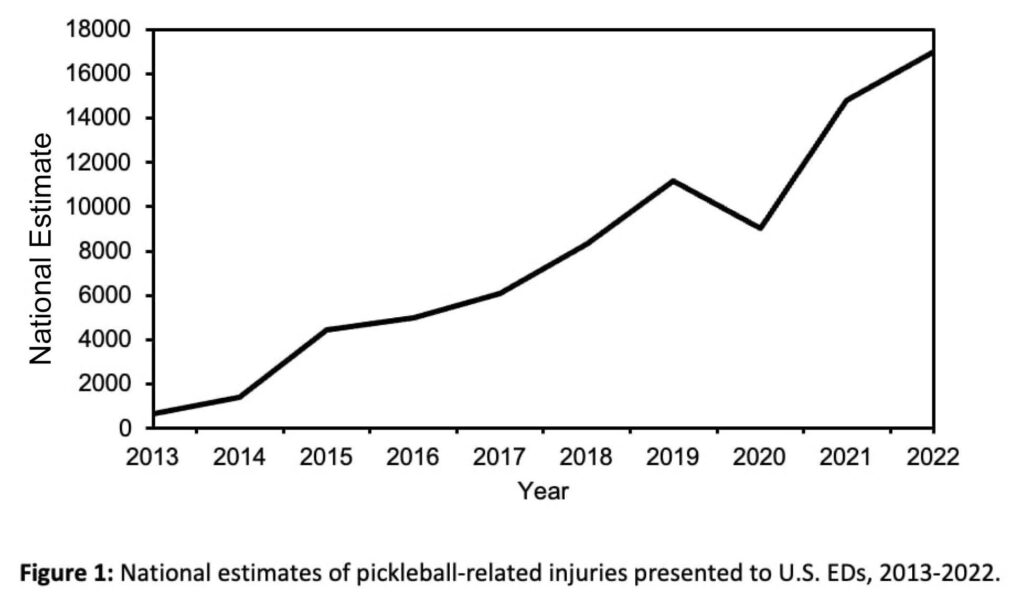
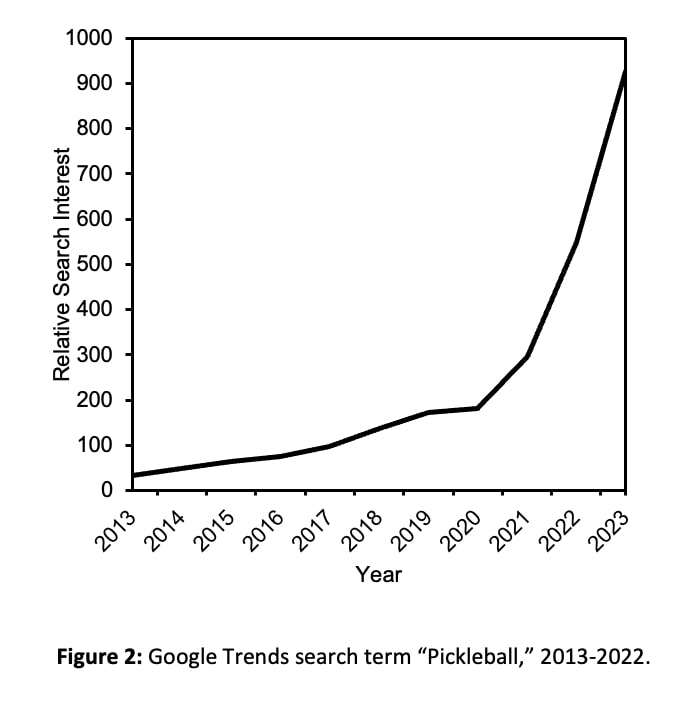
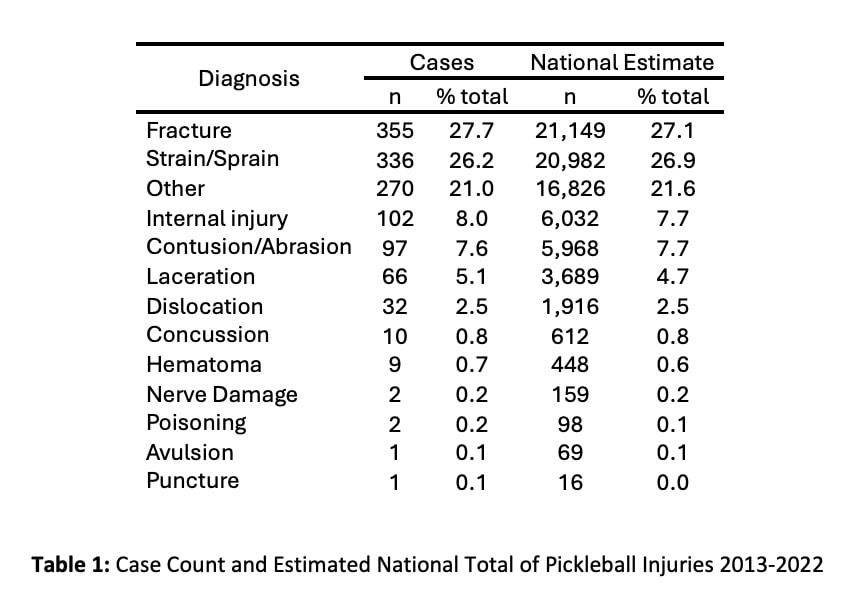
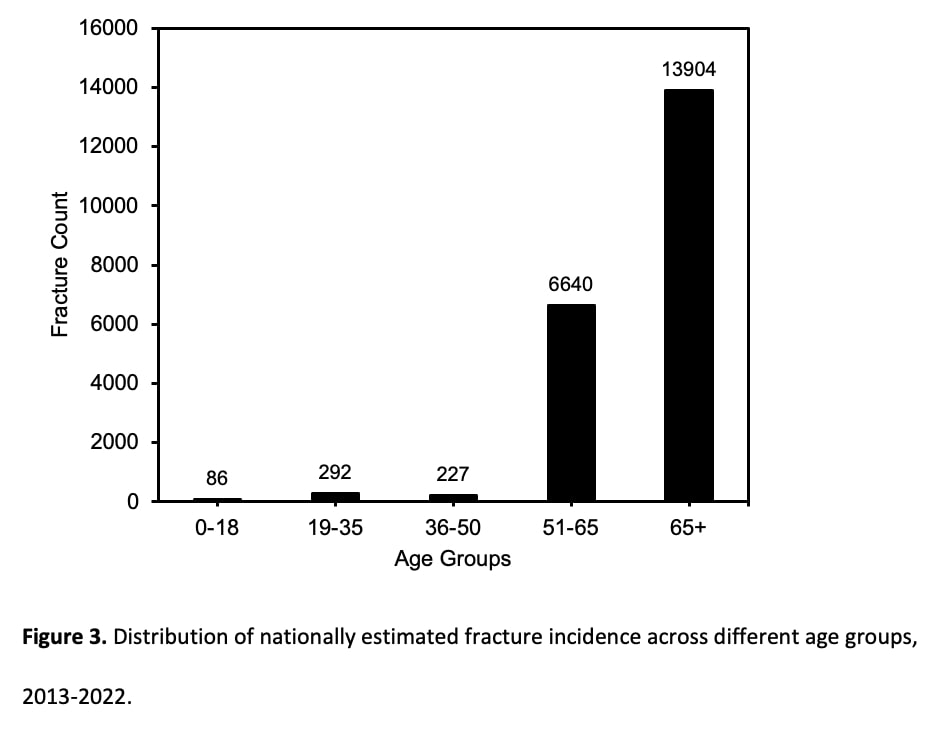
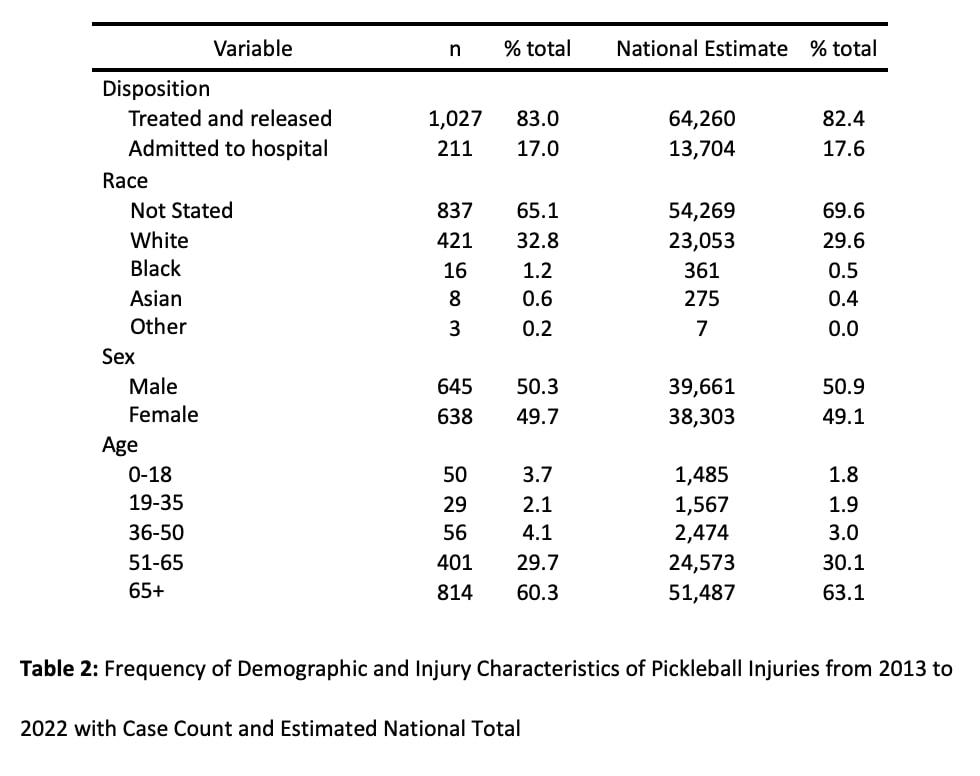
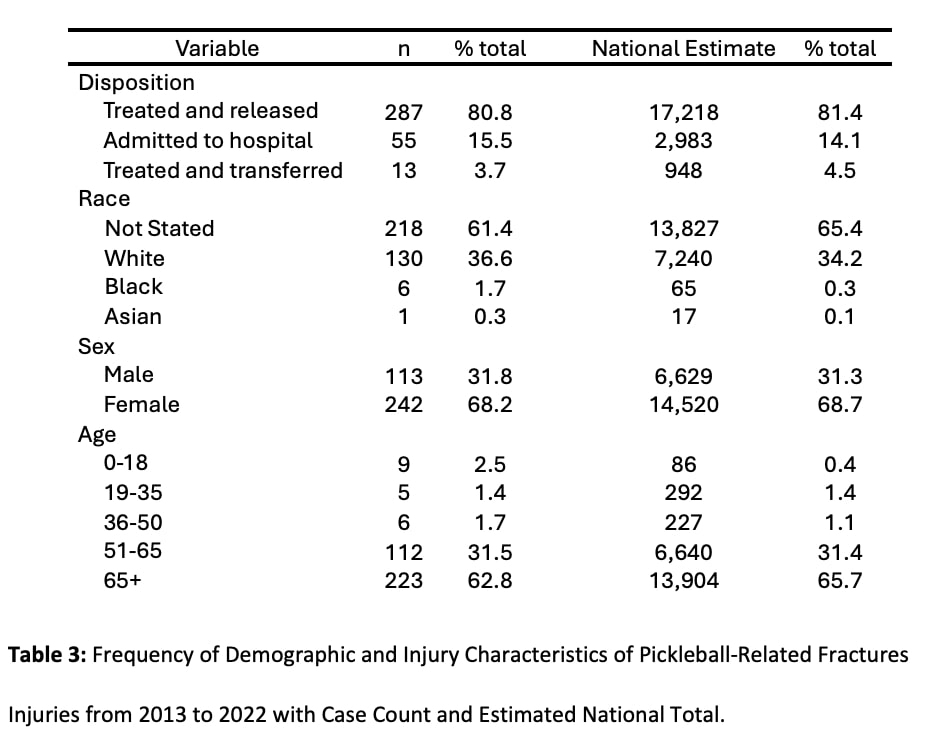
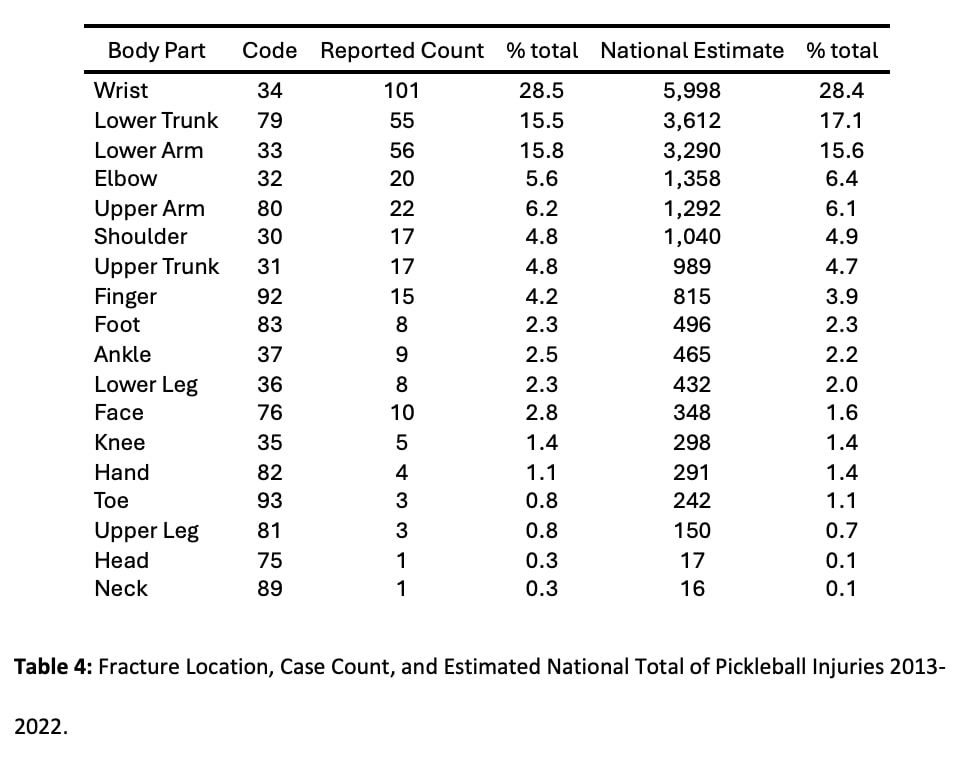
Discussion
While men and women have comparable injury rates (50.9% for men and 49.1% for women), women experience a disproportionately higher rate of fractures. Women account for 68% of fracture cases, compared to 32% in men. This disparity is likely due to the older, postmenopausal demographic of female players, who are more prone to fractures due to lower bone density. This finding is consistent with similar studies on racquet sports (5,6,9) .
While there has been a notable increase in the number of younger individuals taking up pickleball, this shift in player demographics is not reflected in the injury profiles, as the vast majority of injured players remain those over the age of 65. Although injuries do occur among younger players, their numbers are comparatively low. Pickleball’s popularity among older adults, combined with age-related factors like frailty and slower reaction times, likely explains their higher injury rates. Despite growing interest from younger players, most injuries still occur in older participants. Classic FOOSH (falling on outstretched hand) injuries, common in many racquet sports, often result from the quick lateral movements and upper extremity swinging motions inherent to pickleball (4–6,9,10). In addition to the predisposition to injury in older players, these movements can increase the risk of falls and subsequent wrist fractures, as reflected in our finding that 54% of fractures were localized to the wrist and lower arm.
The Google Trends analysis highlights the increasing popularity of pickleball and its correlation with the rise in overall injury occurrence. This suggests that Google Trends could be a valuable tool for identifying growing injury trends in future studies, particularly as sports or activities gain popularity. Interestingly, a similar pattern was observed in a study examining e-scooter injuries, where the rise in injury incidence corresponded with the increased popularity of e-scooters, as indicated by the frequency of related search terms (11) . This parallel suggests that online search behavior may serve as a proxy for tracking the public health impact of emerging recreational activities.
The need for an awareness of pickleball-related injuries is apparent, as our analysis reveals an 88% increase in pickleball-related injuries treated in emergency departments since 2020 during the study period. This sharp rise highlights the growing injury burden associated with the sport and allows preventive measures to be implemented. Prevention strategies should focus on identifying susceptible players and enhancing patient education and awareness, particularly for those at higher risk of injuries such as sprains and fractures. These injuries can result in extended time away from the court, reduced mobility, and, in severe cases, a lasting impact on long-term quality of life. By providing targeted guidance on injury prevention, including warm-up routines, proper footwear, and gradual exposure to the sport, healthcare providers and coaches can help mitigate these risks and keep players active and healthy.
The primary objective of the NEISS is to collect and compile data on injuries associated with consumer products and activities. Previous inquiries into the injury trends of pickleball, tennis, and other racket sports have used the NEISS as a reliable and validated source of national epidemiological injury data (4–6,9). The study may be subject to selection bias due to its reliance on data exclusively sourced from ED visits recorded in the NEISS database, potentially overlooking injuries treated by other providers such as urgent care or walk-in clinics. Additionally, variations in narrative entries within the database may affect the accuracy and completeness of injury descriptions. We did not account for cases of poly-trauma where multiple injury diagnoses were present, which could be significant. Such cases may involve different patient demographics and distinct injury mechanisms, potentially influencing the overall injury profile. Moreover, the NEISS database does not provide information on the injured player’s skill level. This is a limitation because the mechanism of injury can vary by skill level, as has been demonstrated in other racket sports such as tennis (10). In the data analysis process, we used specific keywords such as ‘pickleball’ and ‘pickle’ to filter relevant cases and exclude non-relevant incidents; however, this approach might have inadvertently excluded cases due to entry errors or terminology variations. To mitigate this limitation, future studies may benefit from incorporating additional keywords or advanced algorithms to better capture pickleball-related instances.
Despite these limitations, this study’s strength lies in its 10-year scope, which provides national estimates that give context to injury trends in this rapidly growing sport. This long-term data allows a greater understanding of how the sport’s growth correlates with injury patterns, offering insights for prevention and future research.
Conclusion
Pickleball is a rapidly growing sport due to its easy learning curve and social appeal. However, the rise in its popularity has been accompanied by an increase in injuries, particularly among older player populations. With pickleball’s rising popularity, it is crucial for healthcare providers to advise participants on injury risks and prevention strategies, ensuring that the sport remains a safe and enjoyable activity for all players.
References
- Greiner N. Pickleball: Injury Considerations in an Increasingly Popular Sport. Mo Med. 2019;116(6):488-491.
- USA-Pickleball-Fact-Sheet-2023.pdf. Accessed February 23, 2024. https://www.usapickleball.org/docs/USA-Pickleball-Fact-Sheet-2023.pdf
- Definition B. SFIA’s Topline Report Shows Americans’ Inactivity Rate Declining. Sports and Fitness Industry Association. Accessed February 23, 2024. https://sfia.org/resources/sfias-topline-report-shows-americans-inactivity-rate-declining/
- Changstrom B, McBride A, Khodaee M. Epidemiology of racket and paddle sports-related injuries treated in the United States emergency departments, 2007-2016. Phys Sportsmed. 2022;50(3):197-204. doi:10.1080/00913847.2021.1892467
- Weiss H, Dougherty J, DiMaggio C. Non-fatal senior pickleball and tennis-related injuries treated in United States emergency departments, 2010-2019. Inj Epidemiol. 2021;8(1):34. doi:10.1186/s40621-021-00327-9
- Forrester MB. Pickleball-Related Injuries Treated in Emergency Departments. The Journal of Emergency Medicine. 2020;58(2):275-279. doi:10.1016/j.jemermed.2019.09.016
- National Electronic Injury Surveillance System (NEISS). U.S. Consumer Product Safety Commission General Information. Accessed October 9, 2024. https://www.cpsc.gov/Safety-Education/Safety-Guides/General-Information/National-Electronic-Injury-Surveillance-System-NEISS
- Google Trends. Accessed October 9, 2024. https://trends.google.com/trends/
- Ghattas YS, Zeblisky P, Cassinat J, Aceto M, Spindler KP, Cannada LK. Pickleball-Related Fractures in the United States From 2002 to 2022: An Analysis Using the NEISS Database. Orthopaedic Journal of Sports Medicine. 2024;12(6):23259671241255674. doi:10.1177/23259671241255674
- Jayanthi N, Sallay PI, Hunker P, Przybylski M. Skill-level related injuries in recreational competition tennis players. Med Sci Tennis. 2005;10:12-15.
- LaGreca M, Didzbalis CJ, Oleck NC, Weisberger JS, Ayyala HS. Increasing Incidence of Hand and Distal Upper Extremity Injuries Associated With Electric Scooter Use. J Hand Surg Am. 2022;47(5):478.e1-478.e7. doi:10.1016/j.jhsa.2021.05.021
- [dataset] U.S. Consumer Product Safety Commission. National Electronic Injury Surveillance System (NEISS). U.S. Consumer Product Safety Commission. 2022. Available from: https://www.cpsc.gov/Research–Statistics/NEISS-Injury-Data


